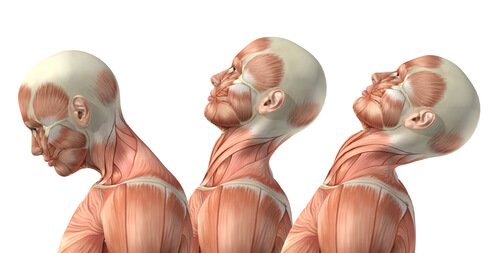Tips on How to Take Care of Your Neck

Neck pain is one of the most common problems of the general population. In most cases, the discomfort is muscular in nature; therefore, they can be easily treated with the use of exercise to take care of your neck.
On the other hand, you should know that some cases of neck pain are due to structural, bone or joint changes. These require attention and thorough medical treatment. Fortunately, the treatment techniques for this particular problem are well-studied and are highly effective.
However, in many cases, how to take care of your neck is as simple as strengthening your muscles. If your neck problem is of this type, you will find a list of exercises below. Still, we have to first have a better understanding of this ailment and its causes. Let’s discuss them.

What are the causes of neck pain?
The possible causes of muscular neck pain are the following:
- Wrong posture maintained for many hours.
- Excessive overuse of the neck muscles. For example, during some sport activities.
- Work stress.
- Use of inappropriate mattresses or pillows for sleeping.
Of course, there are many more causes, but these comprise the vast majority of the cases. Make sure you avoid these causes as much as possible to take care of your neck.
Symptoms of neck pain
Muscular neck pain is distinguished by some symptoms. Its intensity depends on the seriousness of the problem and the general health condition of the patient. Some of the most common problems are the following:
- Pain in the back of the neck.
- Stiff neck and difficulty in movement.
- Headache.
- Feeling of nausea.
- Vertigo and loss of balance.
If you notice these symptoms and if you think they are of muscular type, try to do the following routines. They are effective in strengthening the neck region and greatly alleviate discomforts.
Exercise to take care of your neck
Deep neck flex
The first exercise that we will show you can be done in either a standing or sitting position. To begin, slowly tilt your neck to one side, to the right and then to the left.
Next, with your hand at the side where you are bending your neck, take the wrist of your opposite arm and pull it slightly downward to tighten the contralateral trapezius and shoulder muscles. Hold this position for 20-30 seconds and do it in the other side of your body. Repeat this exercise five times on each side.
Neck rotation
While standing or sitting down, stand with your back straight, while gently flexing your neck in a clockwise direction.
These rotations serve to loosen up your neck muscles and reduce neck tension. During exercise, keep your shoulders and neck relaxed. When you have finished, repeat the rotation exercise in the opposite direction.
Exercise for neck arthritis
This exercise can be done even in front of the computer. Of course, always keep your back straight and well supported at the back of the chair.
To continue, you have to slowly flex your neck to one side, first to the right while trying to get as close as possible to the height of the shoulders. The key is to do it slowly but uninterruptedly. Repeat the exercise between 5 and 10 times per side.
Neck strengthening exercise
To begin, you must cross your hands at the back of your head. Leave the elbows extended sideways and pull your chin back. Remember that your hands should push your head forward while your head resists the pressure.
Continue pressing briefly without doing a dynamic movement. You must apply pressure for 15 to 20 seconds. Take a rest and repeat the exercise for 5 to 10 times.
Neck flexion and extension stretch
To do the final exercise, lower your chin to your chest and look down while sitting. Hold this position for 3-5 seconds.
Gently, return the head to its initial position and stretch it back, performing an extension stretch. Again, you must hold this position for 3-5 seconds. Finally, repeat the complete exercise 3 to 5 times.

Other recommendations
In addition to performing these exercises for neck pain, you may practice other related activities. For example, yoga is a good exercise where you learn to strengthen your back slowly, to adopt good postures that allow you to stretch your back muscles, to relieve the tension in your neck and to maintain a much healthier position everyday.
Finally, if you suspect that it may be something more serious, do not hesitate to consult your doctor.
Neck pain is one of the most common problems of the general population. In most cases, the discomfort is muscular in nature; therefore, they can be easily treated with the use of exercise to take care of your neck.
On the other hand, you should know that some cases of neck pain are due to structural, bone or joint changes. These require attention and thorough medical treatment. Fortunately, the treatment techniques for this particular problem are well-studied and are highly effective.
However, in many cases, how to take care of your neck is as simple as strengthening your muscles. If your neck problem is of this type, you will find a list of exercises below. Still, we have to first have a better understanding of this ailment and its causes. Let’s discuss them.

What are the causes of neck pain?
The possible causes of muscular neck pain are the following:
- Wrong posture maintained for many hours.
- Excessive overuse of the neck muscles. For example, during some sport activities.
- Work stress.
- Use of inappropriate mattresses or pillows for sleeping.
Of course, there are many more causes, but these comprise the vast majority of the cases. Make sure you avoid these causes as much as possible to take care of your neck.
Symptoms of neck pain
Muscular neck pain is distinguished by some symptoms. Its intensity depends on the seriousness of the problem and the general health condition of the patient. Some of the most common problems are the following:
- Pain in the back of the neck.
- Stiff neck and difficulty in movement.
- Headache.
- Feeling of nausea.
- Vertigo and loss of balance.
If you notice these symptoms and if you think they are of muscular type, try to do the following routines. They are effective in strengthening the neck region and greatly alleviate discomforts.
Exercise to take care of your neck
Deep neck flex
The first exercise that we will show you can be done in either a standing or sitting position. To begin, slowly tilt your neck to one side, to the right and then to the left.
Next, with your hand at the side where you are bending your neck, take the wrist of your opposite arm and pull it slightly downward to tighten the contralateral trapezius and shoulder muscles. Hold this position for 20-30 seconds and do it in the other side of your body. Repeat this exercise five times on each side.
Neck rotation
While standing or sitting down, stand with your back straight, while gently flexing your neck in a clockwise direction.
These rotations serve to loosen up your neck muscles and reduce neck tension. During exercise, keep your shoulders and neck relaxed. When you have finished, repeat the rotation exercise in the opposite direction.
Exercise for neck arthritis
This exercise can be done even in front of the computer. Of course, always keep your back straight and well supported at the back of the chair.
To continue, you have to slowly flex your neck to one side, first to the right while trying to get as close as possible to the height of the shoulders. The key is to do it slowly but uninterruptedly. Repeat the exercise between 5 and 10 times per side.
Neck strengthening exercise
To begin, you must cross your hands at the back of your head. Leave the elbows extended sideways and pull your chin back. Remember that your hands should push your head forward while your head resists the pressure.
Continue pressing briefly without doing a dynamic movement. You must apply pressure for 15 to 20 seconds. Take a rest and repeat the exercise for 5 to 10 times.
Neck flexion and extension stretch
To do the final exercise, lower your chin to your chest and look down while sitting. Hold this position for 3-5 seconds.
Gently, return the head to its initial position and stretch it back, performing an extension stretch. Again, you must hold this position for 3-5 seconds. Finally, repeat the complete exercise 3 to 5 times.

Other recommendations
In addition to performing these exercises for neck pain, you may practice other related activities. For example, yoga is a good exercise where you learn to strengthen your back slowly, to adopt good postures that allow you to stretch your back muscles, to relieve the tension in your neck and to maintain a much healthier position everyday.
Finally, if you suspect that it may be something more serious, do not hesitate to consult your doctor.
This text is provided for informational purposes only and does not replace consultation with a professional. If in doubt, consult your specialist.







